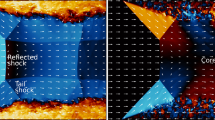Abstract
The new numerical algorithms in SUPER/CESE and their applications in explosion mechanics are studied. The researched algorithms and models include an improved CE/SE (space-time Conservation Element and Solution Element) method, a local hybrid particle level set method, three chemical reaction models and a two-fluid model. Problems of shock wave reflection over wedges, explosive welding, cellular structure of gaseous detonations and two-phase detonations in the gas-droplet system are simulated by using the above-mentioned algorithms and models. The numerical results reveal that the adopted algorithms have many advantages such as high numerical accuracy, wide application field and good compatibility. The numerical algorithms presented in this paper may be applied to the numerical research of explosion mechanics.
Similar content being viewed by others
References
He C J, Yu L Z, Feng Q J. 3D Eulerian numerical simulation method of high speed impact. Explosion Shock Waves, 1999, 19: 216–221
Wu K T, Ning J G. Numerical simulation of the protective effect of complex boundaries toward shock waves in a 3D explosive field. J Beijing Inst Technol, 2003, 12: 50–54
Hallquist J O. User’s Manual for DYNA2D—an Explicit Two-Dimensional Hydrodynamic Finite Element Code With Interactive Rezoning and Graphical Display. Lawrence Livermore National Laboratory Report UCID-18756, Rev.3, 1988
Amsden A A, O’Rourke P J, Butler T D. KIVA-3: A KIVA Program with Block-structure Mesh for Complex Geometries. Los Alamos National Laboratory report La-12503-MS, 1993
Liu K X, Wang J T. Analysis of high accuracy conservation-element and solution-element schemes. Chin Phys Lett, 2004, 21: 2085–2088
Wang G, Zhang D L, Liu K X. An improved CE/SE scheme and its application to detonation propagation. Chin Phys Lett, 2007, 24: 3563–3566
Wang J T. High-Order Scheme of Space-Time Conservation Element and Solution Element Method (CE/SE Method) and Its Applications. Doctor Dissertation. Beijing: Peking University, 2007
Wang G. Numerical Platform of Detonation Waves Based on Improved CE/SE Method. Doctor Dissertation. Beijing: Peking University, 2009
Chang S C. The method of space-time conservation element and solution element—a new approach for solving the Navier-Stokes and Euler equations. J Comput Phys, 1995, 119: 295–324
Zhang Z C, John Yu S T, Chang S C. A space-time conservation element and solution element method for solving the two- and three-dimensional unsteady Euler equations using quadrilateral and hexahedral meshes. J Comput Phys, 2002, 175: 168–199
Zhang D L, Xie W, Guo C M, et al. Numerical simulation of cellar structures and Mach reflection of gaseous detonation waves. Explosion Shock Waves, 2001, 21: 161–167
Shu W C, Osher S. Efficient implementation of essentially non-oscillatory shock-capturing schemes. J Comput Phys, 1988, 77: 439–471
Adalsteinsson D, Sethian J A. A fast level set method for propagating interfaces. J Comput Phys, 1995, 118: 269
Peng D, Merriman B, Osher S, et al. A PDE-based fast local level set method. J Comput Phys, 1999, 155: 410–438
Enright D, Fedkiw R, Ferziger J, et al. A hybrid particle level set method for improved interface capturing. J Comput Phys, 2002, 183: 83–116
Taki S, Fujiwara T. Numerical simulation on the establishment of gaseous detonation. Prog Astron Aeronaut, 1984, 94: 186–200
Kee R J, Rupley F M, Meeks E, et al. Chemkin-III: A Fortran Chemical Kinetics Package for the Analysis of Gas-phase Chemical and Plasma Kinetics. UC-405, Report SAND96-8216, 1996
Sichel M, Tonello N A, Oran E S, et al. A two-step kinetics model for numerical simulation of explosions and detonations in H2-O2 mixtures. P Roy Soc Lond A Mat, 2002, 458: 49–82
Tian Z, Guo Y H, Hao B T. Numerical investigation of propagation of the gas-droplet detonation wave and shock wave. Chin J Comput Phys, 2000, 17: 131–136
Ben-Dor G. Regions and transitions of nonstationary oblique shock-wave diffractions in perfect and imperfect gases. UTIAS Report No. 232, 1978
Wang J T, Liu K X, Zhang D L. An improved CE/SE scheme for multi-material elastic-plastic flows and its applications. Comput Fluids, 2009, 38: 544–551
Wang J T, Zhang D L, Liu K X. A Eulerian approach based on CE/SE method for 2D multimaterial elastic-plastic flows. Chin J Comput Fluids, 2007, 24: 365–401
Liu K X, Liu W D, Wang J T. et al. Atomic-scale bonding of bulk metallic glass to crystalline aluminum. Appl Phys Lett, 2008, 93: 081918
Roy G D, Frolov S M, Borisov A A, et al. Pulse detonation propulsion: Challenges, current status, and future perspective. Prog Energ Combust, 2004, 30: 545–672
Author information
Authors and Affiliations
Corresponding author
Rights and permissions
About this article
Cite this article
Wang, G., Wang, J. & Liu, K. New numerical algorithms in SUPER CE/SE and their applications in explosion mechanics. Sci. China Phys. Mech. Astron. 53, 237–243 (2010). https://doi.org/10.1007/s11433-009-0266-z
Received:
Accepted:
Published:
Issue Date:
DOI: https://doi.org/10.1007/s11433-009-0266-z




